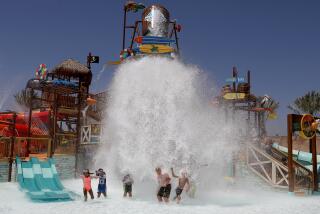Rapids Transit at Wildwater Kayak Races
- Share via
Having studied and fretted over her passage beforehand, Katharine Edmonson sliced her paddle into the Kern River and pulled through the first wave of the Limestone rapids.
A knot of people perched on river boulders yelled out encouragement and shook cowbells. As the stern of Edmonson’s kayak hit a rock with a sound like a bass drum, she grimaced, jamming her paddle down with her left hand to maintain momentum and face the next wave. She slid through, leaned into her paddling strokes again and picked up speed toward the finish line to more cheers.
“It means so much to me just to be here competing,” Edmonson said after her run. “I had butterflies, but I got them flying in formation.” She finished 10th in the race and overall ranks 12th in the world among women.
Edmonson was the only hometown contestant in the 2003 Wildwater World Cup races, which were held recently near Kernville, Calif., and drew about 75 contestants from 15 countries. The athletes qualify for and represent national teams, but they compete individually in the six World Cup races, which vary in length and difficulty.
Although the object is to finish the course fastest, wildwater differs from other competitive paddle sports in that there are no gates or other man-made obstacles determining how a paddler runs the river. Wildwater World Cups are held in years when the sport’s world championship competition is not taking place.
This year’s races were held on stretches of the Upper Kern River, about halfway between Giant Sequoia National Monument and Kernville. Snowmelt from the southern Sierra Nevada powers the Upper Kern around narrow granite-faced cliffs and over ancient flood beds, forming broad waves, eddies and “holes.”
The rapids are among the most daunting on any California mountain river. Deaths from trauma and drowning are not uncommon here. No one was hurt this day, but a few contestants toppled over in the waves, causing the crowd to hush until the kayaker successfully rolled up topside or swam to safety. Cowbells shook for every racer, a happy twist for some European contestants accustomed to stony silence or even boos from non-countrymen.
The racers were electronically timed over a section of river that takes several minutes to paddle. Racers sought the path of least resistance, as they picked their way through rapids and paddled all-out on flat stretches.
“It’s very hard,” said Mexican contestant Alfonso Sanchez Quintero in Spanish. “But as we practice, we get better and better each time.”
Light and strong, the kayaks have V-shaped hulls and are crafted of composite carbon, fiberglass and Kevlar. The vessels aren’t inexpensive -- at $3,000 or more -- but they can be patched cheaply with duct tape or fiberglass resin. In the hands of master paddlers, the kayaks glide as fast as a small motorboat and weave around river rocks like a car negotiating orange cones in a handling test.
“Well, the first time I got in one, I flipped and then I swam,” said Clay Wilder with a wry smile. Wilder and Tyler Dyer, both 17, count the Kern as just another stop on their summer vacations before their senior year in high school. Members of the U.S. junior wildwater team, both were about to head to Austria for the junior world championships.
The two teenagers have been paddling rivers nearly half their lives and were recruited through paddling organizations for wildwater competition.
Many young expert paddlers in the U.S. aim for a spot on the Olympic kayak slalom team, or hone freestyle tricks at river events around the country in hopes of attracting sponsorship money. But not Wilder and Dyer, who have organized their lives around wildwater kayaking, a sport largely unknown in America.
“Wildwater requires more skill and athleticism and the course is longer than other kayaking events,” Dyer said. “These boats are hard to turn, and you have to read the river perfectly.”
In contrast, Olympic kayaking incorporates shorter courses and gates suspended over the rapids, which contestants must navigate perfectly or risk adding penalty seconds to their time. Wildwater is simpler.
“It just Point A to Point B, really,” said Martyn Steele of the British squad.
Racers from well-funded national teams like those of Britain and France need to score high to maintain their status as professional wildwater kayakers. The Italians, Czechs, Slovakians, French and Germans battled for the top spots.
European teams support their athletes in various ways, by paying salaries and travel costs and providing trainers, coaches and boats.
Not every athlete is subsidized. While one gets a rubdown and motivational speech before his race, another from a poorer squad frantically patches holes in his boat with duct tape.
Anne Cairns, a New Zealander swimmer-turned-kayaker, said she and her teammate financed a portion of their trip with proceeds from gambling machines in pubs in her hometown.
With a less-established national team, the American side included die-hards and try-hards largely financing their racing careers through local sponsors and day jobs.
John Pinyerd, a regional sales manager for a Georgia trucking firm, was working when he wasn’t in the water.
“The Europeans have advantages in equipment, infrastructure and training,” he said. “This is their life. This is what they do, and they’re good at it. For me, this is hobby stuff. I’m making sales calls at lunch while they’re taking naps.”
More to Read
Sign up for Essential California
The most important California stories and recommendations in your inbox every morning.
You may occasionally receive promotional content from the Los Angeles Times.













